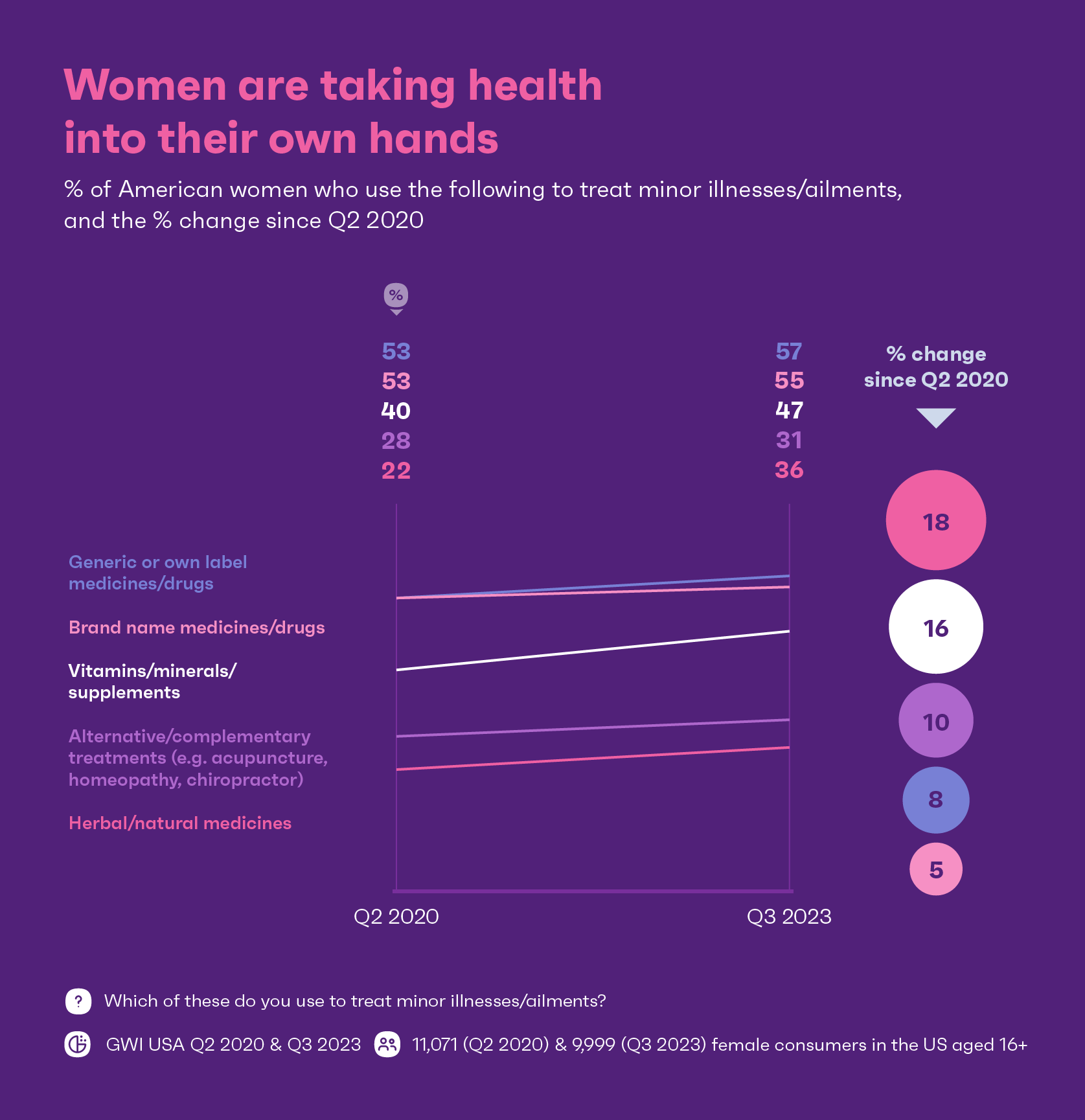Gender bias is found in many places and medical research holds no exception. It took until 1990, the same year NASA launched the Hubble Space Telescope (which was decades in the planning), for the National Institutes of Health to establish their Office of Research on Women’s Health.
Fast forward 30 years, and we’ve seen numerous decisions that have helped reshape attitudes towards women’s health, including influential policy change, but as we head towards 2024, women continue to voice mistreatment or misdiagnosis, showing there’s still a mountain to climb.
Our consumer research data highlights persistent gender disparities within healthcare, with insights on the different ways women are taking their health into their own hands, and how brands outside of the healthcare industry can adopt a more comprehensive approach to women’s health.
The current state of play
Before we get into the women’s health trends of 2024, let’s take a step back and look at the current state of play. We can look to the American market to give us clues on the current outlook of women’s health.
In the US, women’s concerns about their personal health have climbed 25% since Q2 2020.

This upward curve is particularly noticeable among Black/African American and Hispanic women. These groups often face disproportionate challenges with issues such as maternity care.
1. Women are looking to female-centric health brands
The apparent gaps in women’s healthcare within mainstream services has given rise to a number of women-centric health brands that offer services covering everything from general check-ups to specific care for menopause and fertility – providing a much needed breath of fresh air to an outdated system. This highlights the important role of brands in shedding light on the unique health concerns of women and contributing to a more inclusive and equitable landscape.
2. Women are embracing natural remedies, vitamins, and supplements to boost their overall wellbeing
Beyond specific health concerns, women are shifting demand towards an increase in overall wellbeing. This shift lays the groundwork for a deeper exploration of how to address women’s health.

Overall we’ve seen preferences growing for vitamins, natural medicines, and alternative treatments. The number of women in the US who say they use herbal/natural medicines to treat minor illnesses/ailments is up by 18% since the end of 2020.
3. Women are prioritizing their gut health
Aligning with the broader global trend, prioritizing gut health is a particular focus for women. Over 1 in 3 women in the US take supplements for digestive health, and we’ve seen a 21% increase in women taking probiotics to treat digestive problems since the end of 2020. But it’s not only certain treatments or medicines where we’ve seen growth, interest in diversified eating habits has also grown.
As studies continue to find links between women’s health issues like PCOS and the gut microbiome, embracing these trends may also have additional benefits. In 2024, adopting a greater focus on ingredients and readily available information on the nutritional benefits of products steers brands towards the responsible education of women’s health, giving women the tools to take health matters into their own hands before they make a trip to the doctor.
4. Consumers want practical measures for women’s health
Examples of how women’s health is vital for the global economy signal that in 2024, brands need to not only focus on their products, but they need to make the health of their female employees a priority.
In the next year, women’s health issues like abortion will be a key concern for voters in the run up to the Presidential election in the US. The issue has already invigorated Americans across the political spectrum, but it’s also the global impact of overturning Roe v. Wade that should draw brands attention not only towards abortion or birth control, but how the momentum to support women’s health simultaneously supports their economic power.

Globally, we see that it’s not only women who are advocating for workplace policies that prioritize women’s health.
42% of men in 10 markets would like to see employers offer paid leave for women’s health issues.
Since July 2022, there’s been an unwavering change in consumers’ prioritizing paid leave for women’s health issues. But there have been some changes to consumers’ needs since we last asked what they would like to see employers do more to support women’s health issues. As of September 2023, education on the misconceptions of women’s health alongside employers providing access to feminine hygiene products has taken greater priority, while supporting the accurate representation of women’s health and donations to women’s health-focused charities have seen slight drops. This shows us that while accuracy is still essential, 37% want more positive representation, and there’s more demand for practical and financial support.
Not only does this foster inclusion in the workplace, but supporting women’s specific health issues should be considered a necessity for retaining female talent. Brands can take inspiration from underwear brand Modibodi that has offered paid leave for menstrual, menopause and miscarriage since 2021.
5. Workplace health benefits should also extend to childcare
Focusing on workplace benefits, limitations for childcare is a significant barrier for women to access healthcare and is a key issue. Employer-provided daycare services have decreased by 17% in the past two years, and just over 3 in 10 female business professionals report that their employers offer paid maternity or paternity leave. Brands need to acknowledge current shortfalls in maternity and paternity benefits by promoting gender equality in caregiving responsibilities. Workplaces can differentiate themselves by investing in daycare facilities, promoting work-life balance, offering paid parental leave and supporting the professional growth of working mothers – 49% of mothers use childcare to allow them to attend work.
Making women’s health a priority
As we navigate the landscape of women’s health, it’s crucial to recognize the powerful movements shaping next year. The trends outlined above paint a complex picture, reflecting both progress and challenges.
Looking forward to 2024, the global conversation around women’s health is set to intensify. Brands must stay tuned in to the evolving needs of women worldwide, ensuring their efforts foster a future where women can confidently chart their path to optimal health and wellbeing.








